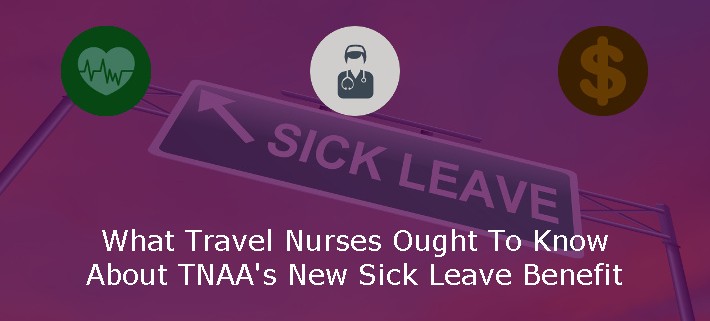What You Ought To Know About Travel Nurse across America’s New Paid Sick Leave Benefit
Many of the benefits that nurses enjoy as permanent employees are hard to come by for travel nurses. Paid sick leave is one such example; you’d be hard-pressed to find a dozen travel nursing companies that offer this benefit. So when Travel Nurse across America (TNAA) announced that they are now offering a paid sick leave benefit, we contacted them to get the details. We’ll share those details and more about paid sick leave for travel nurses in this blog post.
Why Travel Nursing Companies Usually Don’t Offer Paid Sick Leave
To begin, it’s important to discuss why travel nursing agencies typically don’t offer paid sick leave. This way, we’ll understand the obstacles that agencies face when it comes to providing this benefit.
There are several reasons that agencies and recruiters often cite for not providing paid sick leave. First, agencies are only able to bill for the hours that their travel nurses work. There is nothing in the contract between the agency and the hospital that allows the agency to bill for sick days. So, in a sense, agencies don’t have the money to pay for sick leave.
However, there is a way to work around this issue. The agency could factor the cost of sick leave into the standard costs that they attribute to their pay packages. This would lower the pay figures for the traveler, but the traveler would make up the difference when they used the benefit and the agency would be able to account for the cost.
The second reason that agencies often cite for not offering paid sick leave is that hospitals are counting on travelers to work all scheduled shifts and offering paid sick leave somehow contradicts that goal. The hospital wouldn’t open a travel nursing job unless they were in dire need of support.
At the heart of this argument is the notion that paid sick leave is an incentive for travel nurses to miss shifts when they otherwise wouldn’t need to. I’ve always thought this idea was a little overblown. After all, if you’re flat-out too sick to go into work, then the threat of missing pay for the shift isn’t going to magically alleviate your symptoms.
That said, there is at least a little credence to the idea that employees might maintain a lower threshold for calling off sick if they can still get paid. But that might not be a bad thing from a healthcare perspective. After all, sick nurses can spread infection just as easy as any other sick individual.
The third reason that you’ll see cited for not offering paid sick leave is that offering the benefit would make agencies look bad to their client hospitals. Again, the client hospital is counting on the agency to deliver travelers who will tough it out for every scheduled shift. If the hospital believes that paid sick leave is an incentive for missed shifts, and the agency is providing the benefit, then some agencies believe it won’t sit well with the hospital.
Finally, on rare occasions, you might see recruiters claim that some contracts between hospitals and agencies contain a clause that prohibits agencies from offering paid sick leave. I’ve never seen such clauses and doubt they exist. However, anything is possible.
Travel Nurse across America’s Paid Sick Leave Benefit
With all of that in mind, let’s take a look at Travel Nurse across America’s paid sick leave benefit. We spoke with Carla Price, Vice President of Human Resources at TNAA, to obtain the following details:
- The benefit is offered to TNAA travelers in all 50 states.
- The benefit kicks-in after 90 days of employment, which is essentially one 13 week travel contract.
- From day 1, travelers accrue 1 hour of paid sick leave for every 30 hours worked and all hours worked count toward the benefit. To put that in perspective, the standard travel nursing contract is for 13 weeks, 36 hours per week and 468 total hours. You would accrue 15.6 hours of sick-leave for working 1 contract.
- The benefit has a maximum accrual of 80 hours per year and travelers can use up to 40 hours per year.
- If you leave TNAA, your accrued sick-leave will not expire for a period of one year. So, as long as you return to work with TNAA within a 1 year period of leaving, you’ll get to keep your accrued hours.
- The amount paid is determined by the contract being worked at the time that the traveler uses the benefit. TNAA will pay the entire contracted rate including the stipends.
- Sick leave can be used for many reasons including personal illness, medical appointments, or the needs of immediate family members.
As you can see, the benefit is packed with great features. And, given the discussion above about the reasons that agencies typically give for not offering such a benefit, it’s clear that TNAA has faith in their travelers. It’s even fair to say that they’re putting the needs of their travelers first when it comes to this benefit.
This isn’t the first time that TNAA has taken this type of approach either. As we’ve discussed in previous blog posts, almost every agency has a penalty for missing shifts. Well, TNAA’s previous policy was to forgive 1 missed shift per contract for their travelers. Sure, the traveler didn’t get paid their hourly rate, but they didn’t get penalized for the cost of lodging and other items that missed shift penalties are designed to cover. Of course, this policy is no longer in effect as it has been replaced by TNAA’s new paid sick leave benefit, but it goes to show that TNAA has a history of providing quality service.
Evaluating The Value Of TNAA’s Paid Sick Leave Benefit
Finally, it’s important to note that travelers should factor the paid sick leave benefit into their pay package evaluations. As we’ve stated numerous times throughout the blog, it’s always necessary to factor in every compensation variable in order to accurately evaluate and compare pay packages.
Doing this with TNAA’s paid sick leave benefit is actually pretty easy. Start by determining the number of contracted hours for the contract in question. Then, determine how many sick-leave hours you’ll accrue over the course of the contract. Remember, you get 1 hour for every 30 hours worked.
Next, you can figure out the amount you’ll receive per hour for the sick time should you use it. Now, this isn’t a perfect method because in most cases you will actually be using the sick time on a future contract with a potentially different pay rate. However, using the rate of your current contract will at least give you a very good idea of the benefit’s value.
When you’re comparing TNAA’s rates with offers that you receive from other companies, be sure to factor this value in to your evaluation. You may find that TNAA’s rates are higher even without the benefit factored in. You may also find that factoring in the benefit evens things out or makes TNAA’s package more valuable than other packages.
Of course, you may also find that other companies are offering more. The important thing is that ALL compensation variables are considered when evaluating travel pay packages. You can review this video to discover how to compare pay packages.
At the end of the day, you’ll need to decide how important the paid sick leave benefit is for you. Either way, we think it’s fair to say that TNAA has come up with a solid benefit that could be truly beneficial for many travelers.




